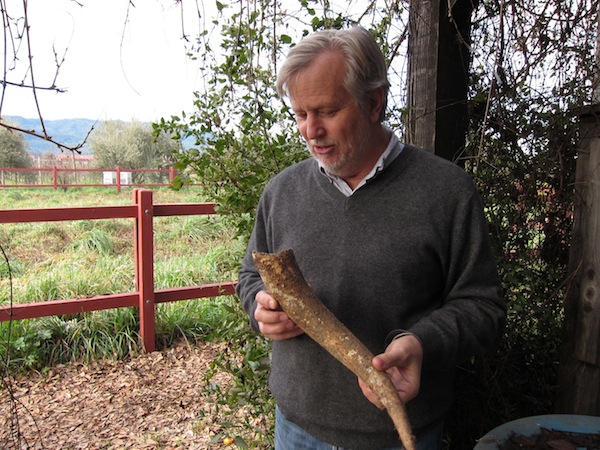Marcel Deiss Burlenberg, charcuterie and artisanal cheeses
 |
| Domaine Marcel Deiss Burlenberg Pinot noir |
France’s Alsace region is not known for its Pinot Noir. Invariably they are lightweights; light in body, light in fragrance, light in flavor. But if there ever was a case for the veracity of biodynamic viticulture, it might be the 2001 Marcel Deiss Burlenberg (about $40); farmed by the current heir to the domaine, the incorrigible but inventive Jean-Michel Deiss, who found practical truths in much of the biological and spiritual teachings of philosopher/farmer Rudolph Steiner.
Jean-Michel turned to biodynamics in 1997, after farming organically for some twenty years prior, shortly after becoming convinced that the one unique aspect of Alsatian wines among all other French wines – the bottling of wines by the grape variety rather than regional appellation – was utterly wrong. To Monsieur Deiss, the ultimate quality of a wine is the strength of its sense of place, or terroir, instead of varietal character.
 |
| Jean-Michel (right) and Mathieu Deiss. |
Hence the labeling of Deiss’s crus level wines (re, Burlenberg below), containing no reference to the Pinot noir grapes from which the wine is made (although the vineyard is also planted and co-fermented with a small proportion of the reddish gray skinned variety, Pinot gris).
For Domaine Marcel Deiss, biodynamique has been the key to attaining terroir. No matter what one may think of the spiritual aspects of this type of viticulture, it is, in a sense, the spiritually driven devotion to factors like single vineyard self-sufficiency, soil health, natural yeasts, and implementation of biodiversity forcing vines to unfold their foliage to the sun and dig down deep to express the qualities of the vineyard as much as the grape. This is what invariably distinguishes these wines from conventionally made wines. Or, in the case of most of the domaine's wines: resulting in sensory quality expressing more of the vineyard and less of the grape.
 |
| The caves at Domaine Marcel Deiss. |
As in the ’01 Burlenberg: a brick-ruby red wine steeped in pungent, beef brothy, scrubby/woodsy earthen aromas wrapped around red plummy perfumes; the earthy qualities taking on faintly resiny, burnt twiggy, almost composty bass notes beneath red berry flavors that ring across the palate with peppery spice and vibrant acidity (without being tart), pulled together by a lush, velvety, flowing texture from beginning to end. A lot of words to say: wow.
If you are a Burgundy lover and find similar qualities in the Pinot Noir based reds of Côte de Nuits, it may not be surprising that a few cognoscente have also noted a striking resemblance in the well drained, crushed limestone soil of Deiss’s Burlenberg to that of the soils in some of the finer Burgundian crus, such as Clos de Bèze.
Of course, we may be stretching things. Burlenberg is a source of perfectly delicious, world class Pinot Noir on the strength of its own distinctions. It is as onerous to compare Burlenberg to a Clos de Bèze as it is a Clos de Bèze to Burlenberg.
 |
| Duck prosciutto and Cabra al Romero. |
So singularly expressive is a Burlenberg, in fact, that you may find yourself forgetting whatever you happen to be eating with it. But like all good wines, it could be even better with some canny culinary choices. Personally, I’d opt for a plate of toothsome, earthy, even drippy, oily meats to highlight the same qualities in the wine: some boudin noir or blutwurst (French or German blood sausages), leberwurst over crusty bread, something as simple as fresh, hot chicharrón, or something as laborious or extravagant as duck prosciutto or duck confit.
Of course, the combination of earthy, brothy, perfumed qualities in Burlenberg also makes it a natural with cheeses of more interesting, earthy flavor and textural contrasts. Notably, a Cabra al Romero (Spanish goat cheese coated with rosemary, an herb with which Pinot Noir naturally connects); Zamorano (an earth and nut toned Spanish sheep’s milk cheese); France’s Cabecou Feuille (a goat cheese dipped in plum brandy and sprinkled with coarse pepper, smoothing out Pinot Noir tannins); or one of my favorites, Italy’s Boschetto al Tartufo (a cow and sheep’s milk cheese, as soft and tender as a lush Pinot Noir, and redolent of white truffle specks that mingle magically with the earth and spice notes of a Burlenberg).



Comments
Post a Comment